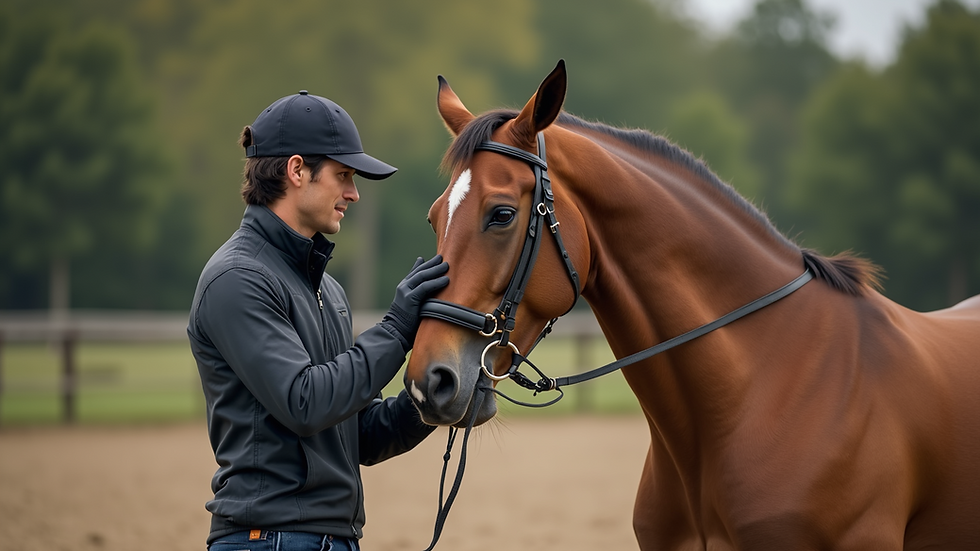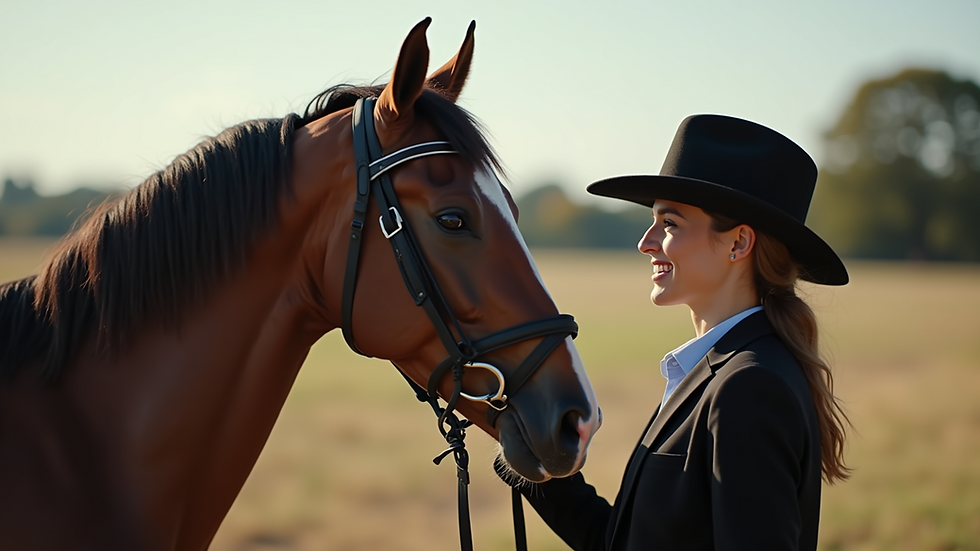Empowering Horses Through Individualized Training Plans
- Macy Johnson
- Jul 5
- 5 min read
Training horses is not just about teaching them commands or tricks. It is about understanding their unique personalities, strengths, and weaknesses. Each horse is different, and so should be their training. Individualized training plans can make a significant difference in how a horse learns and grows.
In this blog post, we will explore the importance of personalized training for horses. We will discuss how to create effective training plans, the benefits of individualized approaches, and share some practical examples.
Understanding the Horse's Personality
Every horse has its own personality. Some are bold and adventurous, while others may be shy or cautious. Understanding these traits is crucial for developing a training plan that works.
Bold Horses: These horses often thrive on challenges. They may enjoy jumping or speed work. Training for them can include more adventurous activities that keep them engaged.
Cautious Horses: These horses may need a gentler approach. They might benefit from slow, steady training that builds their confidence.
By recognizing a horse's personality, trainers can tailor their methods to suit each individual.
Assessing Strengths and Weaknesses
Once you understand a horse's personality, the next step is to assess its strengths and weaknesses. This assessment can guide the training plan.
Strengths: Identify what the horse does well. Is it good at certain movements or tasks? Use these strengths to build confidence.
Weaknesses: Recognize areas where the horse struggles. This could be anything from fear of certain obstacles to difficulty with specific commands. Addressing these weaknesses is essential for a well-rounded training plan.
A balanced approach that leverages strengths while addressing weaknesses will lead to better results.
Creating the Individualized Training Plan
Now that you have a good understanding of the horse's personality and abilities, it is time to create the training plan. Here are some steps to consider:
Set Clear Goals: What do you want to achieve with the horse? Goals should be specific, measurable, achievable, relevant, and time-bound (SMART).
Choose Appropriate Activities: Select activities that align with the horse's strengths and personality. For example, a bold horse may enjoy obstacle courses, while a cautious horse may benefit from groundwork exercises.
Establish a Routine: Consistency is key in training. Create a schedule that includes regular training sessions. This helps the horse know what to expect and builds a sense of security.
Monitor Progress: Keep track of the horse's progress. Adjust the training plan as needed based on how the horse responds.
Incorporate Variety: To keep the horse engaged, include a variety of activities. This can prevent boredom and encourage learning.
By following these steps, trainers can create a comprehensive plan that meets the horse's needs.
The Benefits of Individualized Training
Individualized training plans offer numerous benefits for both horses and trainers. Here are some key advantages:
Improved Learning: Horses learn better when training is tailored to their needs. This leads to faster progress and better retention of skills.
Increased Confidence: A personalized approach helps build a horse's confidence. When they succeed in tasks that suit their abilities, they feel more secure.
Stronger Bond: Individualized training fosters a deeper connection between the horse and trainer. Understanding the horse's needs creates trust and respect.
Reduced Stress: Horses that are trained according to their personalities experience less stress. This leads to a more positive training environment.
Enhanced Performance: Ultimately, individualized training can lead to better performance in competitions or other activities.
These benefits highlight the importance of taking a personalized approach to horse training.
Practical Examples of Individualized Training
To illustrate the effectiveness of individualized training plans, let’s look at a few practical examples.
Example 1: The Bold Jumper
Consider a horse named Max. Max is a bold jumper who loves to leap over obstacles. His trainer, Sarah, recognizes this strength and creates a training plan that focuses on jumping techniques.
Activities: Sarah includes various jumping exercises, such as grid work and courses with different heights.
Goals: They set a goal for Max to compete in a local jumping competition within six months.
Monitoring: Sarah tracks Max's progress, noting improvements in his technique and confidence.
As a result, Max not only excels in jumping but also enjoys the training process.
Example 2: The Cautious Mare
Now, let’s look at Bella, a cautious mare who is nervous around new environments. Her trainer, John, takes a different approach.
Activities: John focuses on groundwork exercises that build Bella's confidence. He introduces her to new environments gradually.
Goals: The goal is to help Bella feel comfortable in various settings, aiming for a trail ride in three months.
Monitoring: John observes Bella's reactions and adjusts the plan as needed.
Through this individualized approach, Bella becomes more confident and relaxed, making her training enjoyable.
The Role of Communication
Effective communication is vital in individualized training. Trainers must be able to read their horses and respond appropriately.
Body Language: Horses communicate through body language. Understanding these signals can help trainers adjust their methods.
Verbal Cues: Consistent verbal cues can reinforce learning. Use clear, simple commands that the horse can easily understand.
Positive Reinforcement: Rewarding desired behaviors encourages horses to repeat those actions. This can be through treats, praise, or a gentle pat.
By fostering open communication, trainers can create a more effective training environment.
The Importance of Patience
Training horses is not a race. It requires patience and understanding.
Take Your Time: Each horse learns at its own pace. Rushing the process can lead to frustration for both the horse and trainer.
Celebrate Small Wins: Acknowledge progress, no matter how small. This builds confidence and motivation for both the horse and trainer.
Stay Positive: Maintaining a positive attitude can make a significant difference. Horses can sense emotions, and a calm, encouraging trainer will help them feel secure.
Patience is a key ingredient in successful horse training.
Building a Support Network
Having a support network can enhance the training experience.
Seek Advice: Connect with other trainers or horse owners. Sharing experiences and tips can provide valuable insights.
Join a Community: Consider joining local riding clubs or online forums. These communities can offer support and encouragement.
Professional Help: If needed, don’t hesitate to seek help from a professional trainer. They can provide guidance and expertise tailored to your horse's needs.
A strong support network can make the training journey more enjoyable and effective.
Embracing the Journey
Training a horse is a journey, not just a destination.
Enjoy the Process: Take time to appreciate the small moments. Each training session is an opportunity to learn and grow together.
Adapt and Evolve: Be open to changing the training plan as needed. Horses can surprise us, and flexibility can lead to unexpected successes.
Build Lasting Relationships: The bond formed during training can last a lifetime. Cherish the connection you build with your horse.
By embracing the journey, trainers can create a fulfilling experience for both themselves and their horses.

Final Thoughts
Empowering horses through individualized training plans is a rewarding experience. By understanding each horse's unique personality, strengths, and weaknesses, trainers can create effective and engaging training programs.
The benefits of personalized training are clear. Improved learning, increased confidence, and stronger bonds are just a few of the advantages.
As you embark on your training journey, remember to be patient, communicate effectively, and enjoy the process. Each horse has its own story, and with the right approach, you can help them write a beautiful chapter in their lives.
So, take the time to invest in your horse's training. The results will be worth it, and the journey will be unforgettable.


Comments